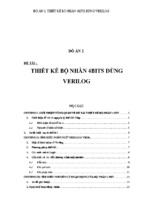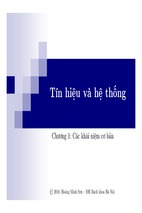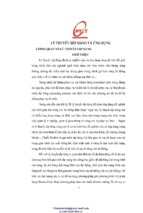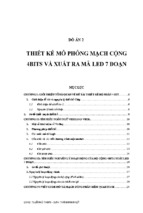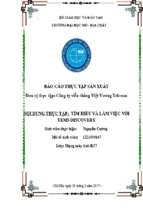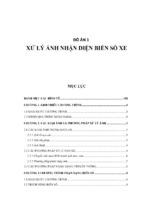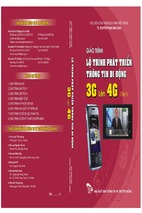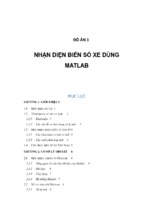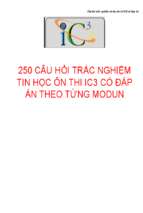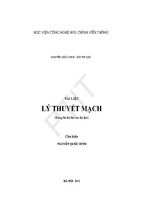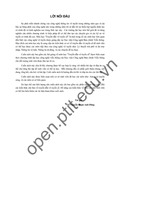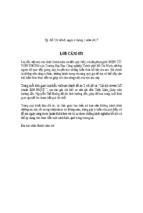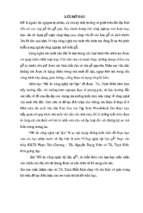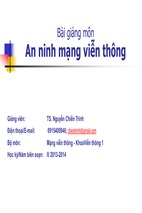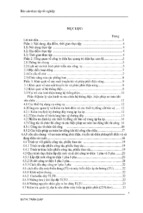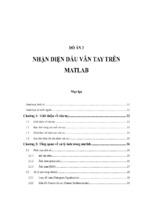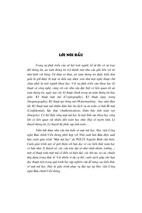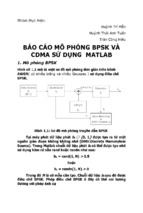Mô tả:
Giao diện LTE
LTE Air Interface
Slide 1
NokiaEDU
LTE Air Interface
LTE Radio Planning Essentials Course
RA4120 FL16A/TL16A
RA41203EN16AGLA0
RA41203EN16AGLA0
© Nokia 2016
1
LTE Air Interface
Slide 2
Copyright and confidentiality
The contents of this document are proprietary and
confidential property of Nokia. This document is
provided subject to confidentiality obligations of the
applicable agreement(s).
This document is intended for use of Nokia’s
customers and collaborators only for the purpose
for which this document is submitted by Nokia. No
part of this document may be reproduced or made
available to the public or to any third party in any
form or means without the prior written permission
of Nokia. This document is to be used by properly
trained professional personnel. Any use of the
contents in this document is limited strictly to the
use(s) specifically created in the applicable
agreement(s) under which the document is
submitted. The user of this document may
voluntarily provide suggestions, comments or other
feedback to Nokia in respect of the contents of this
document ("Feedback").
2
Such Feedback may be used in Nokia products
and related specifications or other documentation.
Accordingly, if the user of this document gives
Nokia Feedback on the contents of this document,
Nokia may freely use, disclose, reproduce, license,
distribute and otherwise commercialize the
feedback in any Nokia product, technology, service,
specification or other documentation.
Nokia operates a policy of ongoing development.
Nokia reserves the right to make changes and
improvements to any of the products and/or
services described in this document or withdraw
this document at any time without prior notice.
The contents of this document are provided "as is".
Except as required by applicable law, no warranties
of any kind, either express or implied, including, but
not limited to, the implied warranties of
merchantability and fitness for a particular purpose,
RA41203EN16AGLA0
are made in relation to the accuracy, reliability or
contents of this document. NOKIA SHALL NOT BE
RESPONSIBLE IN ANY EVENT FOR ERRORS IN
THIS DOCUMENT or for
any loss of data or income or any special,
incidental, consequential, indirect or direct
damages howsoever caused, that might arise from
the use of this document or any contents of this
document.
This document and the product(s) it describes
are protected by copyright according to the
applicable laws.
Nokia is a registered trademark of Nokia
Corporation. Other product and company names
mentioned herein may be trademarks or trade
names of their respective owners.
© Nokia 2016
RA41203EN16AGLA0
2
LTE Air Interface
Slide 5
RA4120 – Learning Elements list
Introduction & Roadmaps
LTE/EPS Overview
LTE Air Interface
Air Interface Overheads
RRM overview
LTE Link Budget
Cell Range (Coverage Planning)
Radio Capacity Planning
Nokia eNodeB LTE Solution
Initial Parameters Planning
LTE Performance Simulations
5
RA41203EN16AGLA0
© Nokia 2016
RA41203EN16AGLA0
3
LTE Air Interface
Slide 6
Module Objectives
After completing this module, the participant will be able to:
• Describe the basics of the OFDM transmission technology
• Explain how the OFDM technology avoids the Inter Symbol Interference
• Recognise the different between OFDM & OFDMA
• Identify the OFDM weaknesses
• Review the key OFDM parameters
• Analyze the reasons for SC-FDMA selection in UL
• Describe the LTE Air Interface Physical Layer
• Explain LTE Cell acquisition and call set up
• Identify LTE Measurements
• List the frequency allocation alternatives for FDD LTE
6
RA41203EN16AGLA0
© Nokia 2016
RA41203EN16AGLA0
4
LTE Air Interface
Slide 7
Module Contents
• OFDM Basics
• OFDM & Multipath Propagation: The Cyclic Prefix
• OFDM versus OFDMA
• OFDM Weaknesses
•
•
•
•
•
SC-FDMA
LTE Air Interface Physical Layer
LTE Cell acquisition and call set up
LTE Measurements
LTE Frequency Variants - FDD
7
RA41203EN16AGLA0
© Nokia 2016
RA41203EN16AGLA0
5
LTE Air Interface
Slide 8
Module Contents
• OFDM Basics
• OFDM & Multipath Propagation: The Cyclic Prefix
• OFDM versus OFDMA
• OFDM Weaknesses
•
•
•
•
•
SC-FDMA
LTE Air Interface Physical Layer
LTE Cell acquisition and call set up
LTE Measurements
LTE Frequency Variants - FDD
8
RA41203EN16AGLA0
© Nokia 2016
RA41203EN16AGLA0
6
LTE Air Interface
Slide 9
Multiple Access Methods
TDMA
• Time Division
User 2
User 1
User 3
User ..
OFDMA
FDMA
CDMA
• Frequency Division
• Code Division
• Frequency Division
• Orthogonal subcarriers
f
f
f
f
t
t
t
f
f
f
t
f
OFDM is the state-of-the-art and most efficient and robust air interface
9
RA41203EN16AGLA0
© Nokia 2016
RA41203EN16AGLA0
7
LTE Air Interface
Slide 10
The Rectangular Pulse
Fourier
Transform
spectral power density
Frequency Domain
amplitude
Time Domain
fs
Ts
1
Ts
fs
time
Advantages:
+ Simple to implement: there is no complex
filter system required to detect such pulses
and to generate them.
+ The pulse has a clearly defined duration.
This is a major advantage in case of multipath propagation environments as it simplifies
handling of inter-symbol interference.
10
RA41203EN16AGLA0
Inverse
Fourier
Transform
frequency f/f s
Disadvantage:
- it allocates a quite huge spectrum. However
the spectral power density has null points
exactly at multiples of the frequency fs = 1/Ts.
This will be important in OFDM.
© Nokia 2016
RA41203EN16AGLA0
8
LTE Air Interface
Slide 11
OFDM Basics
• Transmits hundreds or even thousands of separately modulated radio
signals using orthogonal subcarriers spread across a wideband channel
Total transmission bandwidth
15 kHz in LTE: fixed
Orthogonality:
The peak ( center
frequency) of one
subcarrier …
…intercepts the
‘nulls’ of the
neighboring
subcarriers
11
RA41203EN16AGLA0
© Nokia 2016
RA41203EN16AGLA0
9
LTE Air Interface
Slide 12
OFDM Basics
- Data is sent in parallel across the set of subcarriers, each subcarrier only transports a part of the
whole transmission
- The throughput is the sum of the data rates of each individual (or used) subcarriers while the power is
distributed to all used subcarriers
- FFT ( Fast Fourier Transform) is used to create the orthogonal subcarriers. The number of subcarriers is
determined by the FFT size ( by the bandwidth)
Power
bandwidth
frequency
12
RA41203EN16AGLA0
© Nokia 2016
RA41203EN16AGLA0
10
LTE Air Interface
Slide 13
OFDMA Parameters in LTE
- Channel bandwidth: DL bandwidths ranging from 1.4 MHz to 20 MHz
- Data subcarriers: the number of data subcarriers varies with the bandwidth
• 72 for 1.4 MHz to 1200 for 20 MHz
13
RA41203EN16AGLA0
© Nokia 2016
RA41203EN16AGLA0
11
LTE Air Interface
Slide 14
LTE Air Interface Specifications
•The LTE radio interface is standardised in the 36-series of 3GPP Release 8.
The detailed physical layer structure is described in five physical layer
specifications.
LTE is standardised in the 36-series of 3GPP Release 8:
TS 36.1xx Equipment requirements (terminals, eNodeB)
TS 36.2xx Layer 1 (physical layer) specifications
TS 36.3xx Layer 2 and 3 specifications
TS 36.4xx Network signaling specifications
TS 36.5xx User equipment conformance testing
OFDMA
SCFDMA
Subcarriers
eNodeB
Physical layer specifications:
TS 36.201 Physical layer; General description
TS 36.211 Physical channels and modulation
TS 36.212 Multiplexing and channel coding
TS 36.213 Physical layer procedures
TS 36.214 Physical layer; Measurements
Frequency
14
RA41203EN16AGLA0
© Nokia 2016
RA41203EN16AGLA0
12
LTE Air Interface
Slide 15
Module Contents
• OFDM Basics
• OFDM & Multipath Propagation: The Cyclic Prefix
• OFDM versus OFDMA
• OFDM Weaknesses
•
•
•
•
•
SC-FDMA
LTE Air Interface Physical Layer
LTE Cell acquisition and call set up
LTE Measurements
LTE Frequency Variants - FDD
15
RA41203EN16AGLA0
© Nokia 2016
RA41203EN16AGLA0
13
LTE Air Interface
Slide 16
Propagation delay exceeding the Guard Period
2
1
3
Time Domain
Delay spread > Tg
ISI
4
TSYM
Tg
BOL
1
time
2
time
Tg: Guard period duration
ISI: Inter-Symbol Interference
3
time
4
time
16
RA41203EN16AGLA0
© Nokia 2016
The Guard Period should be designed such that it is always longer than the multipath delay
spread, in order to avoid inter-symbol interference between successive OFDM symbols.
Note that in the example of this slide, the Guard Period is too short, so there will be intersymbol interference!
RA41203EN16AGLA0
14
LTE Air Interface
Slide 17
OFDM symbol
The Cyclic Prefix
•
In all major implementations of the OFDMA
technology (LTE, WiMAX) the Guard Period is
equivalent to the Cyclic Prefix CP.
•
This technique consists in copying the last part of
a symbol shape for a duration of guard-time and
attaching it in front of the symbol (refer to picture
sequence on the right).
•
CP needs to be longer than the channel multipath
delay spread (refer to previous slide).
•
A receiver typically uses the high correlation
between the CP and the last part of the following
symbol to locate the start of the symbol and begin
then with decoding.
OFDM symbol
OFDM symbol
OFDM symbol
Cyclic
prefix
17
RA41203EN16AGLA0
Part of symbol used for
FFT processing in the
receiver
© Nokia 2016
RA41203EN16AGLA0
15
LTE Air Interface
Slide 18
The OFDM Signal
18
RA41203EN16AGLA0
© Nokia 2016
•The OFDM signal is made of multiple subcarriers.
•The distance between the center frequencies of the subcarriers is exactly the inverse of the
Symbol period (Ts). Bigger Ts means subcarriers will allocated closer and more subcarriers
could be allocated on a given spectrum bandwidth.
•An OFDM symbol is the combination of “n” subcarrier Symbol being produced in parallel at
the same time.
RA41203EN16AGLA0
16
LTE Air Interface
Slide 19
Module Contents
• OFDM Basics
• OFDM & Multipath Propagation: The Cyclic Prefix
• OFDM versus OFDMA
• OFDM Weaknesses
•
•
•
•
•
SC-FDMA
LTE Air Interface Physical Layer
LTE Cell acquisition and call set up
LTE Measurements
LTE Frequency Variants - FDD
19
RA41203EN16AGLA0
© Nokia 2016
RA41203EN16AGLA0
17
LTE Air Interface
Slide 20
OFDM
Plain OFDM
•
OFDM stands for Orthogonal Frequency Division
Multicarrier
•
OFDM: Plain or Normal OFDM has no built-in multipleaccess mechanism.
•
This is suitable for broadcast systems like DVB-T/H which
transmit only broadcast and multicast signals and do not
really need an uplink feedback channel (although such
systems exist too).
•
Now we have to analyze how to handle access of multiple
users simultaneously to the system, each one using OFDM.
1 UE 1
20
2 UE 2
3 UE 3
RA41203EN16AGLA0
subcarrier
time
.
.
.
.
.
.
.
.
.
.
.
.
...
...
...
...
.
.
. ...
...
...
...
...
common info
(may be addressed via
Higher Layers)
© Nokia 2016
RA41203EN16AGLA0
18
LTE Air Interface
Slide 21
OFDMA®
Orthogonal Frequency
Multiple Access
OFDMA®
OFDMA® stands for Orthogonal Frequency Division
Multiple Access
•
registered trademark by Runcom Ltd.
•
The basic idea is to assign subcarriers to users based on their
time
bit rate services. With this approach it is quite easy to handle
high and low bit rate users simultaneously in a single system.
But still it is difficult to run highly variable traffic efficiently.
The solution to this problem is to assign to a single users so
called resource blocks or scheduling blocks.
•
•
such block is simply a set of some subcarriers over some time.
A single user can then use 1 or more Resource Blocks.
1 UE 1
21
2 UE 2
3 UE 3
RA41203EN16AGLA0
subcarrier
•
•
common info
(may be addressed via
Higher Layers)
1
1
1
.
.
1.
1
3
3
3
1
1
1
.
.
1.
1
3
3
3
...
1 2 2 ...
1 2 2 ...
1 2 2 ...
. . .
. . .
1. . . ...
1
...
3 3 3 ...
3 3 3 ...
3 3 3 ...
Resource Block (RB)
© Nokia 2016
RA41203EN16AGLA0
19
LTE Air Interface
Slide 22
Module Contents
• OFDM Basics
• OFDM & Multipath Propagation: The Cyclic Prefix
• OFDM versus OFDMA
• OFDM Weaknesses
•
•
•
•
•
SC-FDMA
LTE Air Interface Physical Layer
LTE Cell acquisition and call set up
LTE Measurements
LTE Frequency Variants - FDD
22
RA41203EN16AGLA0
© Nokia 2016
RA41203EN16AGLA0
20
- Xem thêm -

